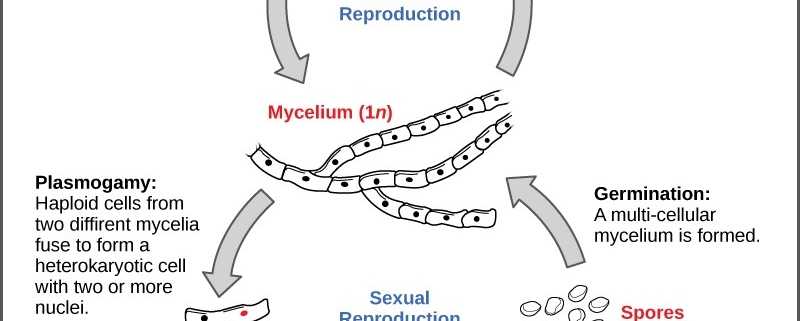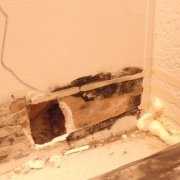The Life Cycle of Fungi
The life cycle of fungi can follow many different patterns. For most of the molds indoors, fungi are considered to go through a four-stage life cycle: spore, germ, hypha, mature mycelium. Brundrett (1990) showed the same cycle pattern using an alternative diagram of the developmental stages of a mould. The majority of mold fungi do not have sexual stages and following this simple life cycle pattern.
Other life cycle patterns differ from this four-stage cycle in that different reproduction mechanisms and physiology characteristics are present, esp. for non-moldy fungi (such as wood rots, etc.).
The Life Cycle of Fungi – Spores
Fungi reproduce by releasing airborne spores, which have different shapes and dimensions. Through spore liberation (the process of detachment of spore from the spore-bearing structure) and spore dispersal (the subsequent movement of the spore before settling on a material surface), spores travel through air, water and event on other insects from fungal infesting areas into homes and rest on surfaces and in building envelope. Concentrations of spores in outdoor and indoor air have been the target for much research (Ingold, 1971 and Darrell, 1974).
Spore diameters (Unit: micron):
- Alternaria, 8-75,
- Aspergillus 2-10,
- Cladosporium4-20,
- Epicoccum 20,
- Penicillium 3-5,
- Periconia 16-18,
- Stemphylium 23-75,
Spores present in the air settle on surfaces. When conditions are favorable, spores start the growth process. Spores go through four stage of development: maturation, dormancy, activation, and germination (Burnett, 1976). The combined process is usually referred to as germination, and will be discussed in more detail in the next section.
Spore Activation
Once activated and germinated, the resulting germ tube is ready to grow into hyphae, then a cluster mycelium when conditions are favorable. In this (vegetative) growth stage, fungi produce microscopic, cylindrical filaments, the thread-like cellular strands called hyphae, into the food sources (material). These hyphae produce and excrete digestive enzymes in the food and take up nutrients in watery form, and transport them to the growing hyphal tips. The hyphae grow by extending itself on the tip or by branching out new threads at the tip and in the older parts. The total quantities of hyphae produced by a fungus are collectively termed as a mycelium. Figure 5 shows images of some mycelia.
The mycelium grows into the material (substrate), consumes its organic components in the process, wakens the structure of the material, and eventually destroys the structure and renders the material incapable to fulfil its function.

 © biology.gatech.edu
© biology.gatech.edu
 © American Federation of Government Employees Local 1237
© American Federation of Government Employees Local 1237 



